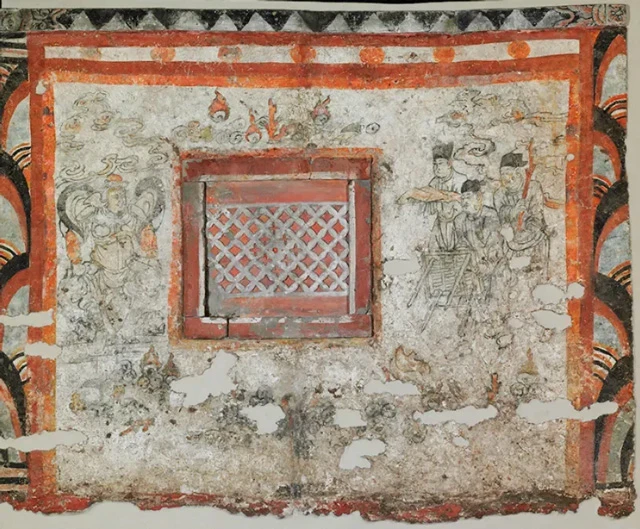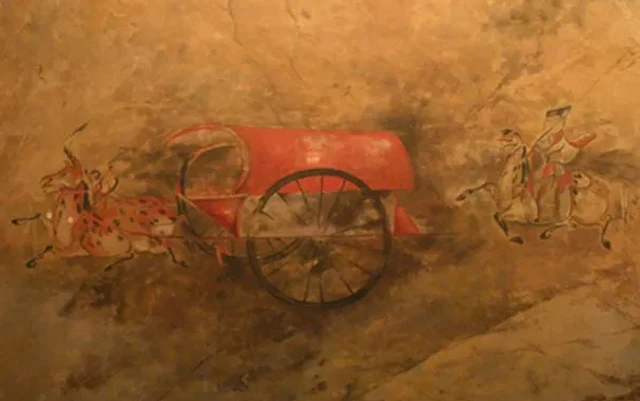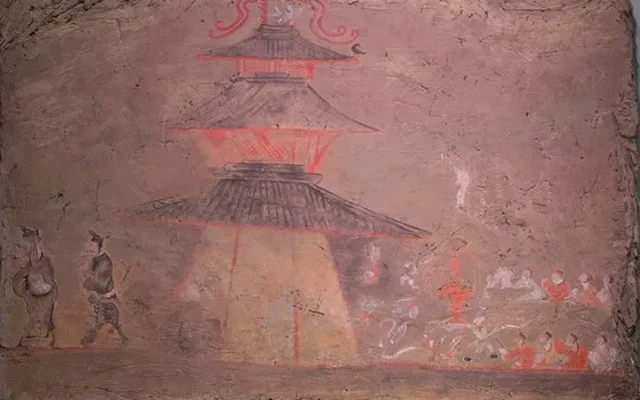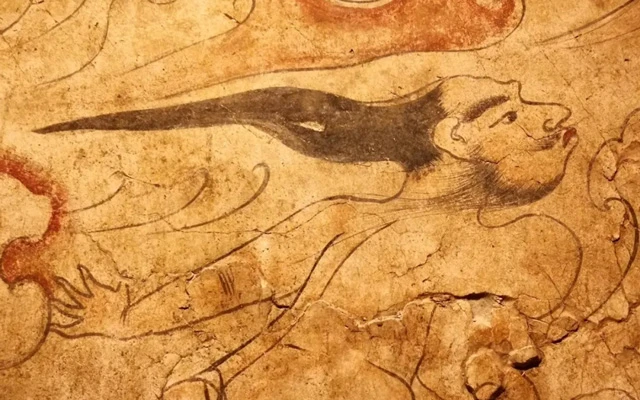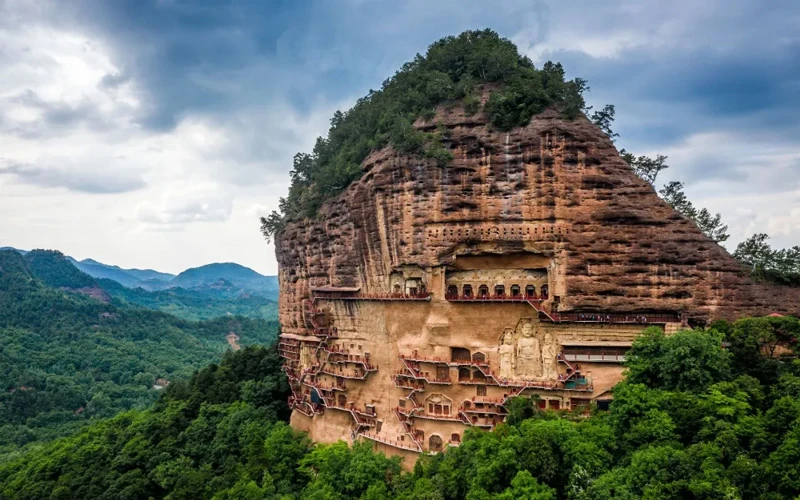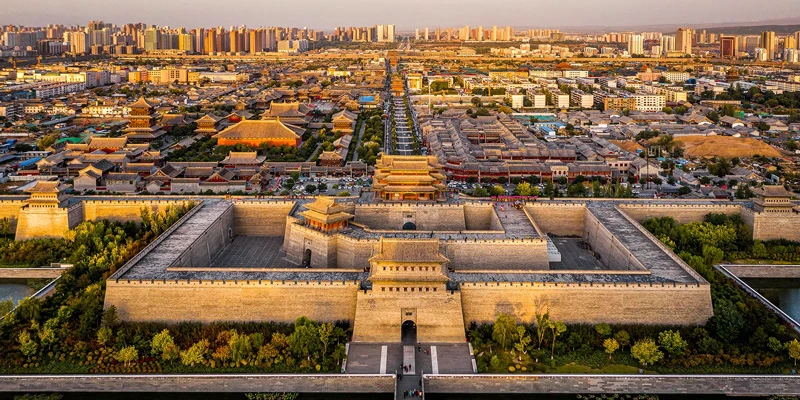On May, the much-anticipated exhibition "The Diverse Life of Song-Jin Dynasty Murals in Shanxi" opened at the Shanxi Museum. For the first time, this exhibition brings together 89 pieces (15 groups) of precious Song and Jin Dynasty murals and brick carvings from Shanxi, inviting us to delve into the unique allure of these historical artworks.
The exhibition vividly showcases themes such as home, celebrations, family values, and wishes depicted in Song-Jin murals, transporting us back to the everyday life of that era. For instance, the mural tomb in Nanguan Village, Fanshi County, Shanxi Province, is a Jin Dynasty brick-carved mural tomb. The tomb murals reflect the traditional layout of Jin Dynasty burial customs in the Central Plains, featuring various treasures, male and female attendants, rockeries and birds, offerings of wealth, and guardian spirits, all illustrating the colorful imagination of the afterlife, striving to ensure a prosperous and stable future world.
Murals, one of the oldest forms of Chinese painting. Often found on the walls and ceilings of halls, tombs, temples, and grottoes, these murals provide a glimpse into the social, religious, architectural, artistic, and folk developments over the past two thousand years.
In addition to Shanxi’s rich murals, regions from Xinjiang to Dunhuang, from Yungang to the Tang tombs in Shaanxi, house numerous mural treasures passed down through five thousand years of civilization. In this article, Art Culture China presents a curated list of the most famous ancient Chinese murals since the Han Dynasty, each a must-see and yet continually fading treasure.
1. Liaoyang Tomb Murals
- Era: Han to Wei Periods
- Location: Banks of the Taizi River, Liaoyang, Liaoning Province
The representative murals of the Han and Wei periods are found in the tomb clusters north of Liaoyang, along the Taizi River banks, including Bangtaizi, Beiyuan, Sandaogou, Xiaoqingduizi, Dongtaizi, and Nantaizi. These tombs originally featured large burial mounds and chambers built from light blue stone slabs, with murals painted directly onto the stone walls.
The murals primarily depict the experiences and daily lives of the tomb owners, featuring vibrant colors and a wide range of subjects. These include gate guards, performing arts, carriages and escorts, banquets, kitchens, towers and residences, armories, acrobatics, and cockfighting. The tomb ceilings often depict the sun, moon, and flowing clouds, offering a comprehensive depiction of the luxurious lifestyle of aristocratic families during the Han and Jin periods.
These murals, dating back 1,600-1,700 years, are renowned for their richness in content and vivid colors. They are outstanding examples of classical realism and invaluable resources for studying the political, economic, and cultural aspects of the Han and Wei periods. They also represent a crucial stage in the history of Chinese art and form one of the foundational bases for the development of traditional Chinese painting.
2. Hexi Corridor Tomb Murals
- Era: Wei-Jin Period
- Location: Jiayuguan, Jiuquan, and Dunhuang, Gansu Province
The Hexi Corridor, stretching from the Yellow River to the east of Xinjiang, is renowned for its above-ground grottoes. However, many are unaware that beneath the ground lies the world's largest "underground gallery" of murals. Scattered beneath Jiayuguan, Jiuquan, and Dunhuang are numerous underground mural brick tomb clusters from the Wei-Jin period.
These murals vividly depict the reality of life at the time, including scenes of farming, animal husbandry, silkworm cultivation, banqueting, travel, military exercises, and hunting. They provide valuable material for studying the political, economic, cultural, military, ethnic, folk, and climatic conditions of the northwest region during the Wei-Jin period. These murals fill a significant gap in the history of Chinese painting from this era.
3. Dunhuang Grotto Murals
- Era: Northern Wei to Yuan Dynasties
- Location: Dunhuang, Guazhou County, Subei Mongol Autonomous County, and Yumen, Gansu Province
Visiting the Dunhuang Grottoes is a must in one's lifetime. This complex includes the Mogao Caves, Western Thousand Buddha Caves, Yulin Caves in Guazhou, Eastern Thousand Buddha Caves, Shixiakou Lower Caves, Subei Wugemiao Caves, Yigemiao Caves, and Changma Caves in Yumen. The construction of these grottoes coincided with the spread of Buddhism in China. Besides stone carvings and clay sculptures of Buddha, these grottoes feature an extensive collection of murals.
The Mogao Caves, initiated in the second year of the Former Qin’s Jian Yuan reign (366 AD), span multiple dynasties, including the Sixteen Kingdoms, Northern Dynasties, Sui, Tang, Five Dynasties, Western Xia, and Yuan. With over 700 remaining caves and more than 4,500 square meters of murals, the content is remarkably rich. Often referred to as an encyclopedia of ancient Chinese art, the murals themselves provide an inexhaustible wealth of knowledge.
4. Northern Dynasties Tomb Murals in Shanxi
- Era: Northern Dynasties
- Location: Shanxi Museum
On December 12, 2019, the "Universe on the Walls – Northern Dynasties Tomb Mural Art Exhibition" opened at the Shanxi Museum. This exhibition showcased the highest artistic achievements of Northern Dynasties tomb murals, including murals from Lou Rui’s tomb (discovered in Wangguo Village, Jinci, Taiyuan), murals from Jiuyuan Gang tomb (discovered in Xiasha Village, Xinzhou), and murals from Shuiquanliang tomb (discovered in Yaozitou Township, Shuocheng District, Shuozhou). These murals vividly display the advanced painting techniques and the authentic social landscape of the Northern Dynasties.
The murals from Lou Rui's tomb filled a significant gap in the art history of Northern Dynasties painting. The Jiuyuan Gang tomb murals include the largest "Hunting Scene" and the most complete "Ascension Scene" of the period. The Shuiquanliang tomb murals were entirely relocated and displayed in the exhibition hall, with all artifacts fully exhibited.
5. Tang Dynasty Tomb Murals in Shaanxi
- Era: Tang Dynasty
- Location: Shaanxi History Museum
Due to the scarcity of paper and silk paintings from the Tang Dynasty, our understanding of Tang painting largely depends on tomb murals. The murals found in Tang tombs, both in terms of quantity and artistic value, are unparalleled. Among the 2,000 Tang tombs excavated over the past decades, many contain precious murals, such as those from the tombs of Crown Prince Yide, Crown Prince Zhanghuai, and Princess Yongtai.
The Shaanxi History Museum houses over 600 Tang tomb murals, covering more than 1,200 square meters. This collection is the largest, highest in quality, most extensive, and best-preserved of its kind in China.
6. Xuanhua Liao Dynasty Tomb Murals
- Era: Liao Dynasty
- Location: Xiabali Village, Xuanhua District, Zhangjiakou, Hebei Province
In 1973, the first excavation of the Liao Dynasty tomb of Zhang Shiqing, a censor, was conducted in Xuanhua District, Zhangjiakou. Subsequently, the nearby tombs of Zhang Shiben, Zhang Gongyou, Zhang Shiyou, Zhang Kuangzheng, Han Shixun, and Zhang Wenzao were uncovered, forming a large mural tomb cluster of the Zhang family.
The murals in these tombs are notable for their high artistic skill, innovative and intricate tomb structures, and the richness of the burial goods, resembling an underground art palace. This discovery is rare in Liao Dynasty archaeology and offers significant research and appreciation value.
The murals, covering over 300 square meters and well-preserved, are crucial for studying Liao Dynasty history, culture, astronomy, folklore, and costumes. Notably, the depictions of music and dance, tea ceremonies, astronomy, travel, maidservants, and scriptures are precious, as they were discovered in China for the first time.
7. Yongle Palace Murals
- Era: Yuan Dynasty
- Location: Longquan Village, Ruicheng County, Yuncheng, Shanxi Province
Yongle Palace was one of the three major ancestral courts of the Quanzhen School during the Yuan Dynasty. The main hall, Sanqing Hall, houses the "Chaoyuan Tu," a masterpiece of Chinese mural art. The mural, 95 meters long, depicts various Taoist deities paying homage to Yuanshi Tianzun. The mural features 286 deity figures, arranged in four to five overlapping layers, all facing one direction in an orderly and grand manner.
The central figures are eight 3-meter-high main deities. The mural includes representations of the Azure Dragon and White Tiger stars in the front and Marshal Tianpeng and Marshal Tianyou in the back. Other characters, including 28 principal deities such as the Heavenly Emperor and Queen Mother, and surrounding celestial beings like the 28 mansions and 12 palaces, unfold across the painting. The main deities are depicted with solemnity and grandeur, while the surrounding figures are lively and expressive, each uniquely portrayed.
8. Pilu Temple Murals
- Era: Ming Dynasty
- Location: Shangjing Village, Dubei Township, Shijiazhuang, Hebei Province
Pilu Temple, built during the Tianbao years of the Tang Dynasty, houses murals within the Pilu Hall that are among the "Four Great Ancient Chinese Murals," alongside those in Dunhuang's Mogao Caves, Beijing's Fahai Temple, and Shanxi's Yongle Palace. The temple's murals, covering over 130 square meters, depict a variety of figures including deities, arhats, emperors, and merchants, reflecting everyday life.
The murals blend Confucianism, Buddhism, and Taoism, depicting 508 characters arranged into 122 groups across three layers. Each group is clearly labeled, and the characters are symmetrically positioned. The lower layer features the main figures, standing 1.2 to 1.5 meters tall, aligned at eye level with viewers. These figures are masterpieces, showcasing sophisticated artistry in their designs, outlines, and colors. The murals are invaluable resources for studying ancient social customs, religious history, and art history.
9. Baofan Temple Murals
- Era: Ming Dynasty
- Location: Baofan Town, Pengxi County, Suining, Sichuan Province
Baofan Temple, originally named Arhat Monastery, was built during the Northern Song Dynasty. In 1466, during the Chenghua reign of the Ming Dynasty, the murals were painted. The temple houses 87 murals covering nearly 200 square meters, with a history spanning over 500 years.
These murals, depicting Buddhist stories, feature 103 lifelike figures, each with unique expressions. The scenes blend heavenly and earthly elements, showcasing vibrant life and extraordinary artistic charm. The murals are known for their strong and vigorous brushstrokes, vivid colors, and resemblance to the style of Tang Dynasty painter Wu Daozi. They are highly regarded as "Oriental Immortal Paintings."
10. Fahai Temple Murals
- Era: Ming Dynasty
- Location: Shijingshan District, Beijing
Fahai Temple was constructed between 1439 and 1443 during the Zhengtong reign of the Ming Dynasty. The well-preserved murals inside the temple are considered some of the finest examples of Ming Dynasty mural art.
While most post-Yuan Dynasty murals mix Buddhist and Taoist themes, Fahai Temple's "Empyrean and Brahma Worship Buddha" mural remains purely Buddhist, following the Tang Dynasty style. The composition, layout, and imagery reflect Tang and Song influences.
The Fahai Temple murals are regarded as the epitome of Chinese temple murals, noted for their maturity, elegance, and sublime beauty. Among the most captivating is the depiction of Water Moon Guanyin, whose translucent white silk garment appears to flutter in the breeze. Closer inspection reveals that each hexagonal flower on the silk is composed of about 48 gold threads, demonstrating an astonishing level of detail and craftsmanship.
We believe that every mural is a piece of gold that has survived the test of time, yet continues to face the relentless erosion of history's waves. As we admire these exquisite artworks, it is crucial to focus on their preservation, ensuring that these treasures have a better future.

